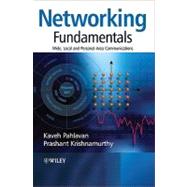
Note: Supplemental materials are not guaranteed with Rental or Used book purchases.
Purchase Benefits
Looking to rent a book? Rent Networking Fundamentals Wide, Local and Personal Area Communications [ISBN: 9780470992906] for the semester, quarter, and short term or search our site for other textbooks by Pahlavan, Kaveh; Krishnamurthy, Prashant. Renting a textbook can save you up to 90% from the cost of buying.
Prashant Krishnamurthy is an associate professor with the graduate program in Telecommunications and Networking at the University of Pittsburgh. At Pitt, he regularly teaches courses on cryptography, network security, and wireless communications and networks. His research interests are wireless network security, wireless data networks, and position location in indoor wireless networks. He is the coauthor of the books Principles of Wireless Networks – A Unified Approach and Physical Layer of Communication Systems and is a co-editor of Information Assurance: Dependability and Security in Networked Systems. He served as the chair of the IEEE Communications Society Pittsburgh Chapter from 2000 to 2005. He obtained his PhD from Worcester Polytechnic Institute, Worcester, MA, in 1999.
| Part 1 | |
| Introduction to Information Networks | |
| Introduction | |
| Evolution of WANs | |
| Evolution of Local Networks | |
| Structure of the book | |
| Part 2 | |
| Characteristics of the Medium | |
| Introduction | |
| Guided Media | |
| Wireless Media | |
| Fundamentals of Physical Layer Transmission | |
| Information Transmission | |
| Transmission Techniques and Signal Constellation | |
| Performance of the Physical Layer | |
| Wideband Modems | |
| Coding and Reliable Packet Transmission | |
| Introduction | |
| Source Coding and Framing Techniques | |
| FEC Coding | |
| Coding for Spread-Spectrum and CDMA Systems | |
| Arq schemes | |
| Flow Control Protocols | |
| Medium Access Methods | |
| Introduction | |
| Centralized Assigned access Schemes | |
| Distributed Random Access for Data-Oriented Networks | |
| Integration of voice and data traffic | |
| Part 3 | |
| The Internet | |
| Infrastructure of the Internet | |
| Addressing | |
| QoS | |
| Bridges or LAN Switches | |
| Switches | |
| Routers | |
| Cellular Networks | |
| Introduction: What Is a Cellular Network? | |
| General Architecture of a Cellular Network | |
| Mechanisms to Support a Mobile Environment | |
| Protocol Stack in Cellular Networks | |
| PHY in TDMA Air Interface | |
| PHY in CDMA Air Interface | |
| Achieving Higher Data Rates in Cellular Networks | |
| Deployment of Cellular Networks | |
| Ethernet | |
| Introduction | |
| Legacy 10 Mb/s Ethernet | |
| Evolution of the PHY | |
| Emergence of Additional Features for Ethernet | |
| IEEE WLAN Standards | |
| Introduction | |
| IEEE 802.11 and WLANs | |
| IEEE 802.16 (WiMAX | |
| IEEE 802.15 WPAN | |
| Introduction | |
| IEEE 802.15.1 Bluetooth | |
| Interference between Bluetooth and 802.11 | |
| IEEE 802.15.3a UWB WPANs | |
| IEEE 802.15.4 ZigBee | |
| Part 4 | |
| Network Security | |
| Introduction | |
| Network Attacks and Security Issues | |
| Protection and Prevention | |
| Detection | |
| Assessment and Response | |
| RF Location Sensing and Geolocation Systems | |
| Introduction | |
| What is Wireless Geolocation? | |
| RF Location Sensing and Positioning Methodologies | |
| LCS Architecture for Cellular Systems | |
| Positioning in Ad Hoc and Sensor Networks | |
| Wireless Sensor Networks | |
| Introduction | |
| Sensor Network Applications | |
| Sensor Network Architecture and Sensor Devices | |
| The PHY Layer in Sensor Networks | |
| The MAC Layer in Sensor Networks | |
| Higher Layer Issues in Sensor Networks | |
| Table of Contents provided by Publisher. All Rights Reserved. |
The New copy of this book will include any supplemental materials advertised. Please check the title of the book to determine if it should include any access cards, study guides, lab manuals, CDs, etc.
The Used, Rental and eBook copies of this book are not guaranteed to include any supplemental materials. Typically, only the book itself is included. This is true even if the title states it includes any access cards, study guides, lab manuals, CDs, etc.